
36 minute read
A Proposal to Harmonize BIM and IoT Data Silos using Blockchain Applications
Zulkefly Abu Bakar1 and Malachy Mathews2
School of Multidisciplinary Technologies Technological University Dublin, Ireland. E-mail: d17123953@mytudublin.ie E-mail: malachy.mathews@tudublin.ie
Advertisement
Abstract ̶ The integration of Building Information Modelling (BIM) and Internet of Things (IoT) provides significant end-to-end benefits for the architecture, engineering, construction, and operations (AECO) industry. Example of applications include on-site assembly services, data localization for built environment, occupancy performance measures and many other analyses that can be used to improve the built environment. However, silos in the BIM and IoT data exchange have impacted the digital process adoption in AECO industry, which aims to change the dynamics and behaviours of the current working process. This study sets out to critically analyse the Blockchain technology’s potential to connect, integrate and advance AECO industry information exchanges and digital processes by using BIM and IoT integration use case as a methodology to identify, clarify and organize the proposed system requirements. This paper presents a comprehensive literature review to uncover the current state of BIM and IoT data silos. Moreover, an online survey assessment and a simulated test were conducted to critically evaluate, investigate, and examine the opportunities and solutions in harmonizing BIM and IoT data silos by using the Blockchain application.
Keywords ̶ BIM, IoT, Blockchain, Digital Twin, Data Silos, Integrated
1.0 INTRODUCTION
The recent Global Lockdown following the COVID19 pandemic has affected many businesses, workforces and multiple parts of supply chains that are not designed to be managed remotely. These businesses have suffered from a disconnected system and fragmented data, which then triggered economic loss and global recession [1]. The “new normal” therefore, will require a smarter way of working and a higher degree of security, transparency, and trust in a data management system [2].
In the architecture, engineering, construction, and operations (AECO) industry, technological advancements such as BIM, and IoT have improved the accuracy of low-level assets information and collaboration between machine and human interfaces [3]. However, the fragmented data and data silos which are commonly created by a centralized, unintegrated database system across two or multiple repositories still exist. To eliminate these obstacles, there is a need for an integrated system that can provide a transparent, unified, and trusted environment [4]. Blockchain technology emerged as a disruptive innovation to democratic data sharing in a decentralised and trusted environment. With a wide range of decentralized applications, Blockchain can be a potential solution to the disintegration of data silos [5].
This research sought to critically analyse, evaluate, and discuss the ability and roles of Blockchain technology and its application in harmonizing BIM and IoT data silos through a literature review, an online survey and a simulated test which aims to critically examine and rationalize the use of the Blockchain technology as a solution for BIM and IoT integration processes.
2.0 LITERATURE REVIEW 2.1 Overview of The Key Technology
2.1.1 Building Information Modelling (BIM)
According to [6] “BIM or building information modelling is a process for creating and managing information across a construction project’s lifecycle. This advancement represents physical and functional characteristics, such as geometry, spatial relationship, and geographic information in a digital format to support decisions during an asset’lifecycle, ” and with
the release of ISO 19650, a more connected and integrated BIM processes are expected [7].
2.1.2 Internet of Things (IoT)
IoT is a system that employs interconnected smart devices to transfer data using internet without necessitating human interactions or human-tocomputercommunication [8]. “TheInternetofThings is a paradigm where everyday objects can be equipped with identifying, sensing, networking and processing capabilities that will allow them to communicate with one another and withother devices and services over the Internet to accomplish some objective” [9].
IoT deployment can be categorised based on the process capability of sensors object’s recognition. The categorisation are as follows; (1) activity-aware objects, (2) policy-aware objects, (3) and processaware objects [10].
Such categorisation is vital in designing the data management framework for a BIM and IoT-based application involving various objects, devices, sensors, and daily items. These objects have been increasingly applied in various smart homes products to enhance work productivity, living comfort, and entertainment.
2.2 Challenges of BIM and IoT Data Integration
The interweave between digital and physical assets either directly or indirectly creates a significant amount of information that can be utilized to improves security, minimizing human effort, saves time, and efficient resource utilization however fragmented data management causes anomalies and inefficiencies between human and machines. The true relationship between BIM and IoT can only be achieved if a Single Source of Truth is established s.
According to [11] data fragmentation happened because data abstracted from the sources are still locked-in silos and stored in isolated databases. Figure 1 shows the current fragmented relationship within BIM-IoT environment that are segregated and locked-in silo.
Figure 1 - Silo and fragmented data management in the current BIM and IoT process. From the literature review, it shows there are several key issues contributing to the poor relationship across silos within BIM and IoT environment. At the outset there is four core themes being addressed in this research, thisincludes, security, fragmented data, data ownership and trust.
2.2.1 Security
This lingering issue concerning IoT applications security has continued to impede the implementation of the technology in the AECO industry. According to the National Institute of Standards and Technology of the United States (NIST), security can be classified as “the protection of the confidentiality, integrity, and availability of a technology solution”. The essence of security is ensuring every component function as established and assuring that authorized and unauthorized users are kept safe from possible threat [12].
However, the connected IoT domains, devices, and sensors to the Internet raise concern about data privacy. IoT devices, by their nature, are vulnerable to attacks from data theft and malicious activities due to their behaviours.
Furthermore,
“the orchestration of IoT in a highly modular environment with many moving parts and inter-dependencies between the stakeholders of this environment has led to many security issues” [10].
System separation and staying offline are not viable security approaches and are ineffective for business operation. The lack of seamless interoperability and integration reduce business outcomes; hence the futile attempt of adopting the IoT in AECO industry [13].
2.2.2 Fragmented Data
[11] indicated that the file-based data management is the prevalent data management strategy in the industry. They further arguedthat the growth of siloed in file-based system is attributed from the traditional systems and processes practised by most businesses. Thiscreates data reliability andinteroperability issues between parties. Lack of BIM and IoT data integration in the AEC industry limit the benefits of integration from being fully realised.
[14] gave an example of how categorisation of trade segments in the current BIM process, project teams (e.g., design team, supply team, construction team, and operations team), has made the exchange of activities between the team members and technological interoperability less feasible. Information was reorganised according to the topdown model and notable resources were used to process submittals, change orders, and RFIs.
However, these approaches are only appropriate for small projects. In a more complex project, level of granularity and document continuity can become an issue [15].
This issue has contributed to significant fragmentation in data management mechanisms and limiting IoT domains access and prevent them from making connection into BIM environment. [15].
Instruments, applications, or software employed to manage business information is also a disintegration source, as these devices function under the information silos model. Common interoperability issues in these sets of tools often limit data sharing between parties [16].
[6] claims that BIM processes lack continuation at the construction, post-construction and operation stage due to fragmented processes between trades and FM operators. They explained, in the post-construction stage, a model does not represent the structure as a living element; it represents only the as-built form of the building. Even during the construction stage, a BIM model is only as good as the information provided to it. If the data is inaccurate, the model will be too. The lack of information continuation in the siloed collaboration model that is maintained within BIM is slowing the construction project from progressing [6].
2.2.3 Data Ownership
Data can be considered as a commodity in Industry 4.0. Its function will allow companies to acquire or maintain a competitive edge. Platforms that capture a critical mass of BIM and IoT data in the near-term will be well-positioned to dominate the built environment market. They will also be challenging to defeat which is attributed to the vendor lock-in approaches which are attained when the building data are completely “transactable” for project contributors and not secured in proprietary systems.
Due to competitiveness, BIM and IoT platforms have no incentive to share data/market with their competitors. No secure mechanism exists to share data in real-time across platforms seamlessly. The lack of policy and solutions to address these interoperability issues are a massive obstacle on innovation within the AECO industry and will continue to fragment the industry into monolithic data silos. Without a new approach that enables data/device sharing and interoperability, the full potential of integrated IoT-based BIM applications cannot be harnessed [17].
Furthermore, data heterogeneity is prevalent in IOT data infrastructure, which contributes to wasted prospects for businesses to generate value and to maximized functions offered by IoT rich datasets [18].
2.2.4 Trust
A primary difficulty in the implementation of BIM and IoT is poor relationship among stakeholders [19]. Trusted relationship is essential for organizational communication which in force its importance as an asset for many organizations [20].
[20] further cited, “as a general approach this trust was enabled by third parties and intermediaries who ensured the contracted parties that they have authority, transparency and legal right to do business with each other. However, this approach on a fastpaced global economy with growing complexity and volume of interaction is increasingly difficult”. Transparency and trust established by a third party has become too complex as information is always concealed, and the procedure is frequently laborious and expensive. Additionally, since the 2008 financial crisis, it become clear that the system was highly vulnerable.
[20] observed that true collaboration encourages professionals to work together in the four modern pillars of procurement, simulated design, lean process, and energy efficiency design. However, [22] observed that this requires trust in partnership, security, assurance in data reliability and information quality before true collaboration can be achieved.
2.3RE-THINKING BIMAND IOTINTEGRATION
[19] recommend project teams must consider approaches that can establish the end-to-end collaboration via a single source of truth covering their organization. Data could be stored and accessed in the cloud database through web services and not be prone to manipulation and fraud. The governance of those data should not be put on any centralised means that can be exposed to actors who often breach their moral duty. However, this required a robust system to ensure reliable data flow. Each business that installs IoT solutions must possess a strategy to safeguard trust, identity, confidentiality, protection, safety and security of devices and people. It is imperative to acknowledge that an IoT device or solution can be threatened at any time. Business owners must observe security as a controllable risk, along with other risks.
The literature review suggestsa number of conceptual solutions for BIM and IoT integration. However, many challenges such as trust, security, data ownership, and management need to be addressed for both technologies to work together.
To achieve and deliver true integration in the BIM and IoT environment, a common system is required for keeping track of the built assets. Also needed is a system that gives definition and order to the society, which comprises security, speed, and transparency. The next section describes and justifies selecting the Blockchain technology as the answer to the issues.
2.4BLOCKCHAIN:DEFINITIONS AND
CHARACTERISTICS
“Blockchain technology is a growing list of records or “Block” that is occupied with collective databases. Every block comprises a cryptographic hash of the previous block, performed data, and timestamp”. The validated data in the blocks are confirmed and secured by a peer-to-peer (P2P) network, which collectively adheres to the consensus mechanism [23].
Figure 2 – Basic Blockchain transaction mechanism The Blockchain technology can be considered as the distribution of trust; it allows people to share their data with others in a verified, immutable environment. Data is administered by a trust-free system, but the realisation of the trust hinges on the framework of generating the trusted interfaces [24].
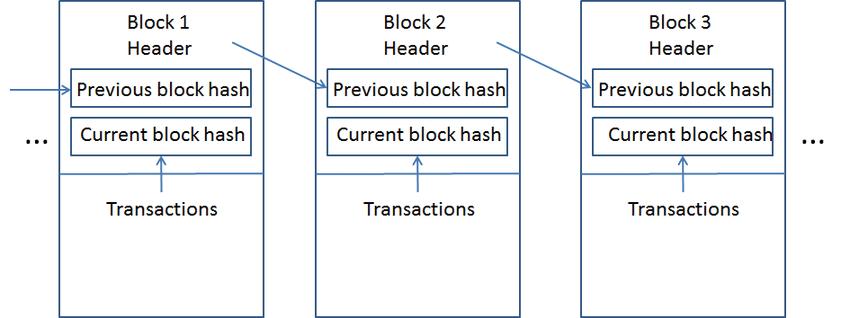
The Blockchain technology also allows individuals, organisations, and domains to have full rights and control over the sharing, collaboration, and privacy of their information without having to rely on third-party intermediaries [25]. This process (Figure 3) and the key characteristics of the technology are discussed in the following section.
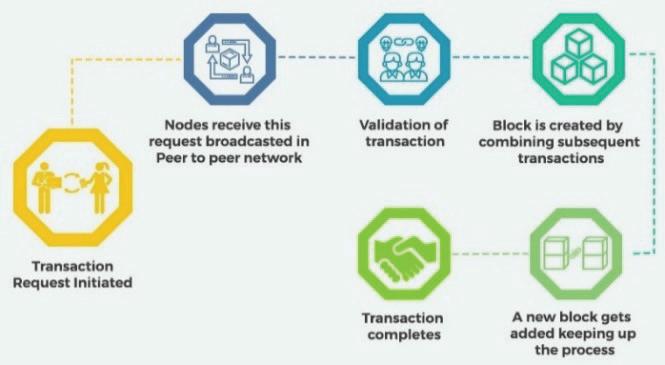
Figure 3 – Blockchain processes [26]
2.4.1 Immutability
Immutability refers to the capability of Blockchain of restore records of data across a peer network of a computer system without losing its accuracy. Each transaction contains a hash of the previous transaction thus making it very difficult to tamper with [25].
Immutability is highly desirable for a supply chain ecosystem. In a Blockchain-based supply chain process, a consensus mechanism is used to improve transparency and provide greater traceability of products or services. Every transaction (including origin, transit, and price) is recorded in an immutable ledger, allowing trust to form and transforming a set of information into the creation of value [5].
2.4.2 Transparency
The usage of Blockchain enables the attainment of transparency by permitting users read-only admission to prior dealings and the capability to review the content of smart contracts. This aspect is valuable for goods that have to be traced in the supply chain. Although transparency is necessary in numerous businesses, such aspects might not be applicable and universal. Private users might be worried about privacy issues over their sensitive personal data, and businesses might experience the fear of sensitive information leakage [27].
2.4.3 Decentralized nature
“Decentralization refers to the process of distributing and dispersing power away from a central authority.” Blockchain is planned as a decentralized, circulated system; consequently, the technology does not have any single point of failure, establishing its resilience, efficiency, and democracy. Decentralisation provides each member a chance to become a network processor [28].
2.4.4 Consensus
The advanced consensus procedures across network nodes have established the realisation of decentralisation. Such protocols guarantee that the responsibilities of accumulating transactions and producing new blocks adhere to stringent instructions, which do not contain bias. The most popular consensus algorithm was applied in Bitcoin, the “proof-of-work” (PoW) mining, is founded on unravelling a mathematically challenging puzzle with dynamically modifiable difficulties [29]. In other words, the Blockchain consensus can lead to new powerful processes for many areas, applications, and organisations.
2.5APPLICABLE USES OF BLOCKCHAIN TECHNOLOGY
In this section, several applicable uses of Blockchain technology to the AECO industry are discussed. Some of these applications can be served for a more specific integrated data management solution or collaboration processes for any new construction projects.
2.5.1 Distributed ledger
Distributed ledger technology (DLT) is a consensus replicate of an asset database which is communal and synchronised across a peer-to-peer network of numerous sites, locations, or establishments [30]. DLT can possibly address privacy and security issues through its undisputable qualities which are unaffected by hacks and modifications [31].
DLT can aid in solving numerous BIM and IoT problems. It can confirm the incorruptibility of information through the immutability and identification of the person making changes along with facts of the variations. This facet enables improved logging and tracing of intellectual property and copyright, contributing to improved assurance of relevant stakeholders to cooperate [32]
2.5.2 Smart contracts
Smart contract features an important role in the Blockchain development. It offers an exclusive interface for “machine-to-machine interaction which provides a safe, trusted, self-managed record and transfer of assets. A smart contract combines user interfaces, protocols, and promises articulated through those interfaces, thus permitting associations to be made formal and protected over public networks. A smart contract will allow users to deploy a metadata on a Blockchain network in a verified environment, directly through deterministic procedures, therefore allowing numerous issues to be addressed without requires validation from a third party” [33]. Indirectly, such feature, promises lowers the legal costs of any project [5].
A smart contract has its properties in the Blockchain, and therefore, the former cannot be changed unless all the actors involved agree to the alteration. Therefore, a smart contract manages and preserves its records of assets on the Blockchain, consequently permitting it to function as an escrow for two or more parties involved in a specified transaction. Since a smart contract existsin the Blockchain, it is practically clear and susceptible to manipulation [34].
The smart contract functions as an independent payment entity on the Blockchain, which could deterministically perform payment after the completion of a job. Automation in many types of repetitive tasks traditionally performed by people can reduce the time, costs, and risks associated with them [35].
The smart contract offers a stimulating prospect for BIM and IoT data exchange methods to directly confront trust issues between the exchanges in both technologies.
2.5.3 Peer-to-Peer Network
“Peer-to-peer network is a distributed and connected computer system or “peers” on the Internet. It enables a highly resilient consensus mechanism for the Blockchain without the need for any intermediary” [36]. [37] in his whitepaper states that the peer-topeer (P2P) network in P2P electronic cash, Bitcoin, helps to prevent double-spending in a transaction by establishing a consensus to record a public transaction. This application can also be incorporated to different practices that requires transactions such as project management, payment, procurement, asset management, and supply chain management. The P2P network at its core can serve as an application for communication management and data validation for an IoT-based BIM application [38].
3.0RESEARCH DESIGN
This research proposes Blockchain as the key technology to support AECO digital transformation thus enabling data transfers and value between the heterogeneous IoT-based BIM applications via crosschain communication. The technology could complement BIM and IoT technology by providing trust in data to inform decision-making and optimise business processes throughout a project’s life cycle.
This research was evaluated, examined, and tested using two methods of gathering data. First method used is a web survey where the self-selected were voluntary and anonymous. The opening questions were formatted to locate demography and roles of the respondents, it then flows into a series of indicator about Blockchain technology characteristics, obstacles and potential use case in AECO industry. The survey closing with an open-ended question, given respondents an opportunity to raised opinions about this research in general. The survey aims to critically evaluate the knowledge level of AECO industry practitioners on their understanding of the Blockchain technology. The results from the survey reflect their perception on the Blockchain spaces for AECO industry.
An action research was then conducted to critically examine the potential of the Blockchain application particularly smart contract in harmonizing data silos for a more secured, integrated, and trusted BIM and IoT environment. A simulated application was tested to gain a deeper understanding about the potential solutions or issues and informed judgment can be achieved.
3.1 Web Survey
The web survey findings highlighted in this paper reflect the participants thinking and perception in the Blockchain spaces and the potentials impact of the technology in AECO industry. The survey polled a sample of thirty AECO professionals in three countries twenty from Ireland, two from Qatar and eight fromMalaysiawith twenty-four represents AEC organization and six represents O&M department.
Findings from the survey suggest a promising digital transformation for many organizations. Thirteen participants implemented more than 50% BIM and IoT processes in either projects or their businesses process but have very low to no uptake of the Blockchain technology. The results indicate an improve use of smart devices in construction projects and Digital Twin for process automation during operation and maintenance phase.

Figure 4 – Blockchain technology potential use cases in AECO industry
The findings also imply the respondents’ optimism about the ability of the Blockchain to potentially play a role in BIM and IoT integration. Twenty-one participants agreed that the character of Blockchain properties could offer a massive opportunity for the industry to become more effective, transparent, productive, and sustainable. The Blockchain technology, BIM and IoT could be utilised for better interoperability in construction, supply chain, payment, contract, and procurement.
However, Figure 4 the twenty-one participants acknowledged, such integration requires a high level of knowledge and understanding of the technology. Though respondents are confident by eliminating old working culture, improve security and find suitable use case for businesses could lead to more take on Blockchain adoption and more impactful digital transformation in their organisation. The respondents also believed that an integrated project delivered through an IoT-based BIM application secured by Blockchain technology would dramatically improve project visibility and data reliability. Such integration would allow the technology to exchange a structured database that can be shared for design and construction automation, energy simulations, fabrication, and the development of artificial intelligent (AI) thus increasing operational efficiency and enhancing risk analysis.
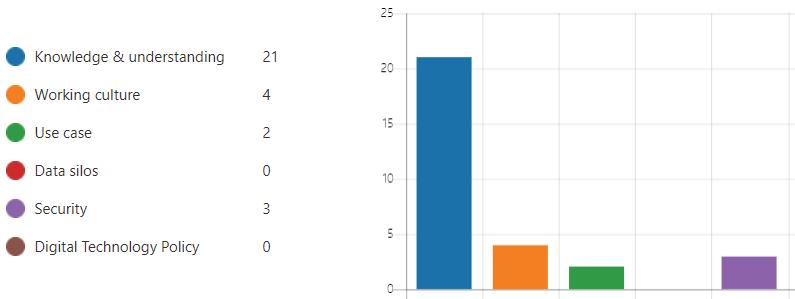
Figure 5 – Blockchain adoption obstacles in AECO industry 3.2ACTION RESEARCH:ASIMULATED APPLICATION This section presents the development of a Blockchain application to demonstrate the possible connection between BIM, IoT, and Blockchain. A simulated test was conducted to explore the various software packages used for Smart Contract developments. The objective of the test was to critically evaluate the value of the Blockchain characteristics in harmonizing BIM and IoT data silos. The test also served to demonstrate the potentials of the Blockchain-based applications, particularly Smart Contract and Distributed Ledger Technology (DLT) to be leveraged in creating a trusted Blockchain backed BIM and IoT cloud
systems.
3.2.1 Methodology
A test of a simulated application, which allows data to be measured and evaluated, were conducted to achieve the objective of the study. The programmed application, a smart contract, was created to demonstrate the combined roles and functions of each technology in securing, distributing, and establishing trust in a shared data environment.
3.2.2 Overview
The smart contract serves to: 1. maintain historical data from an IoT device (see below) and BIM models in a distributed ledger 2. embedded the smart contract between the nodes in the system
3. provide hash-based security, verification of identity and provenance data ownership 4. provide consensus and agreement models for shared information, and 5. create a trust less data management
In this test, the smart contract provides information about a living quality scenario of a meeting room with a specific focus on the use of temperature and humidity information. For this purpose, an IoT device with a temperature and humidity sensors was installed in a meeting room to capture and provide data for the BIM model elements and DLT. This information serves to facilitate reliable data exchanges between the environments. With this information, several statements can be made for quality evaluation of performanceor productsof the measured room. These findings were derived from a process comprising the following four steps:
1. by defining the application (smart contract) parameters and requirements. 2. by designing a harmonised theoretical BIM-
IoT-Blockchain framework. 3. by establishing an implementation approach. 4. by evaluating the results.
3.2.3 Define the Smart Contract parameters and requirement
The purpose of this section is to identify the parameters and requirements for the Smart Contract configuration metadata (source code).The configured source code defined the high-level workflow policies and interaction model of the Smart Contract.
Since Microsoft Azure only support Ethereum based blockchain, Solidity was chosen as Programming language deployed for this test. “Solidity is an objectoriented, high-level language for implementing smart contracts. Smart contracts are programs which govern the behaviour of accounts within the Ethereum state. In this sense, Solidity is a collection of code (its functions) and data (its state) that resides at a specific address on the Ethereum blockchain” [39].
pragma solidity >=0.4.25 <0.6.0; contract AirQuality {
//Set of States enum StateType { Created, InTenancy, Compl eted, OutOfCompliance} enum SensorType { None, Humidity, Temperat ure } Figure 6 – Solidity Smart Contract programming language The configuration metadata contains application name, description and roles that defines the data ownership, permission control and security within the blockchain application. A set of distinct roles are defined based on functionality.
Name Description Parameter
Created Contract has initiated and tracking in progress In tenancy Tenant is currently occupying room
Out of compliance Indicates that the living space is not met H&S requirement
Temperature
Min = 18deg Max = 23deg
Humidity
Min = 40% Max = 60%
Complete Operation and maintenance have been carried out Table 3 – Smart contract States
3.2.4 Data harmonization Design methods
The architecture for the build, manage and deploy solutions for the Smart Contract application was first defined. This test was carried on Vendor-Locked solution due to the limitations of the Open-Software and Open-Protocols available during this study.
Microsoft azure platform was utilized as the common data platform for building, managing, and deploying solutions for the smart contract applications. Microsoft Azure also provides a cloud service such as IoT hub, virtual machines, SQL server, Blockchain Workbench etc. that can be used to automate data processing for a smarter and more efficient IoT and Blockchain data management.
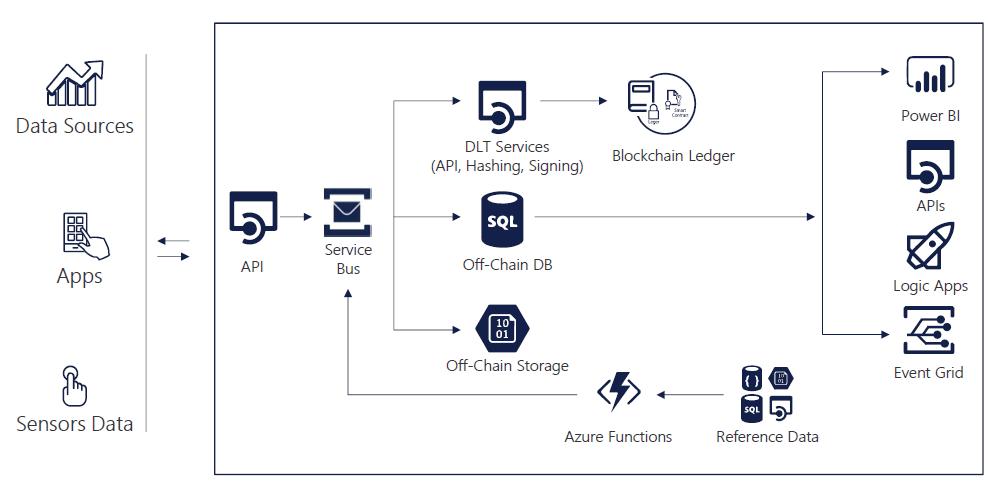
Figure 7 - MicrosoftAzure IoT and Blockchain Architecture solution [40] Harmonization of the system was evaluated across three environments:
1. A BIM environment which represents the project deliverables in terms of model element for both 3D and information contents (object properties).
Interconnectivity between BIM model and the
Azure platform was achieved via Autodesk Forge protocols.
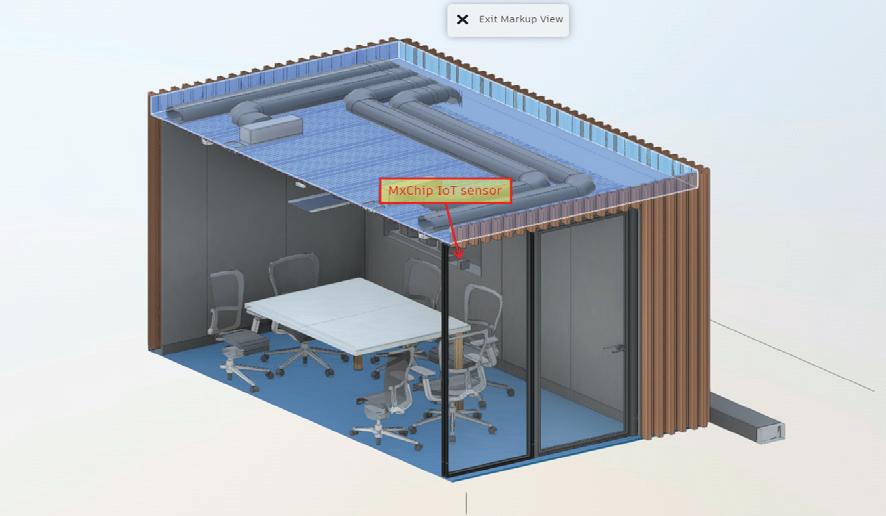
Figure 8 – Virtual twin model represents IoT information 2. An IoT environment which “represents the actual delivery ofthe physical asset, goods, and services where IoT-based verification and authentication of the performance can occur” [32]. Azure
MXchip IoT Devkit was used to develop and prototype the IoT solutions on the Microsoft
Azure IoT hub. The Real-time data captured from these registeredsensors for eachspace were published to an IoT hub and were forwarded to a
Smart contract application on the Azure
Blockchain Workbench. 3. A Blockchain environment, which consists of a set of services that allow users to deploy
Blockchain applications on the cloud. In the
Azure platform, Blockchain Workbench provides the deployment solutions for the Smart Contract including blockchain stack, application templates, and support for IoT integration. This helps to simplify the development and ease experimentation with prebuild applications. The time taken to develop the Blockchain applications could be reduced significantly.
3.2.5 Implementation
With the established configuration metadata and framework design, the actual implementation can be carried out. The following diagram articulates the possible data flow harmonization across the three environments. A more detailed explanation regarding the application implementation workflow is outlined in the steps below and is shown in the sequence diagram in Figure 10.
Figure 10 –A sequence diagram showing data harmonization across technological environments.
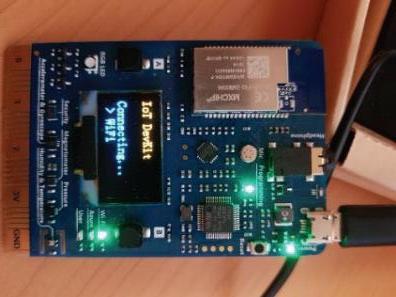
Figure 9 - MXchip IoT Devkit

3.2.6 Workflow
Step 1 - The simulated application showcases an example of a smart contract process with BIM and IoT monitoring for health and safety compliance. The MXchip IoT Devkit with a temperature and humidity sensors was installed in a meeting room to capture and provide telemetry data. Set of parameter Compliance rules were specified and must be met for the room to be considered safe by the occupants. Acceptable range target parameter set as below;
Temperature
Min = 18deg Max = 23deg
Humidity
Min = 40% Max = 60%
Step 2 - BIM models were initiated to web viewer to host metadata from digital assets. BIM models that were authored in Autodesk Revit were used as a virtual twin to provide an accurate representation of geometrical data for web-based data monitoring and reporting. The Revit model were then translated into Serial Vector Format (SVF) via Postman; the collaboration platform for API development so that it can be rendered in the web viewer. The web app is used to visualize data captured from the sensor.
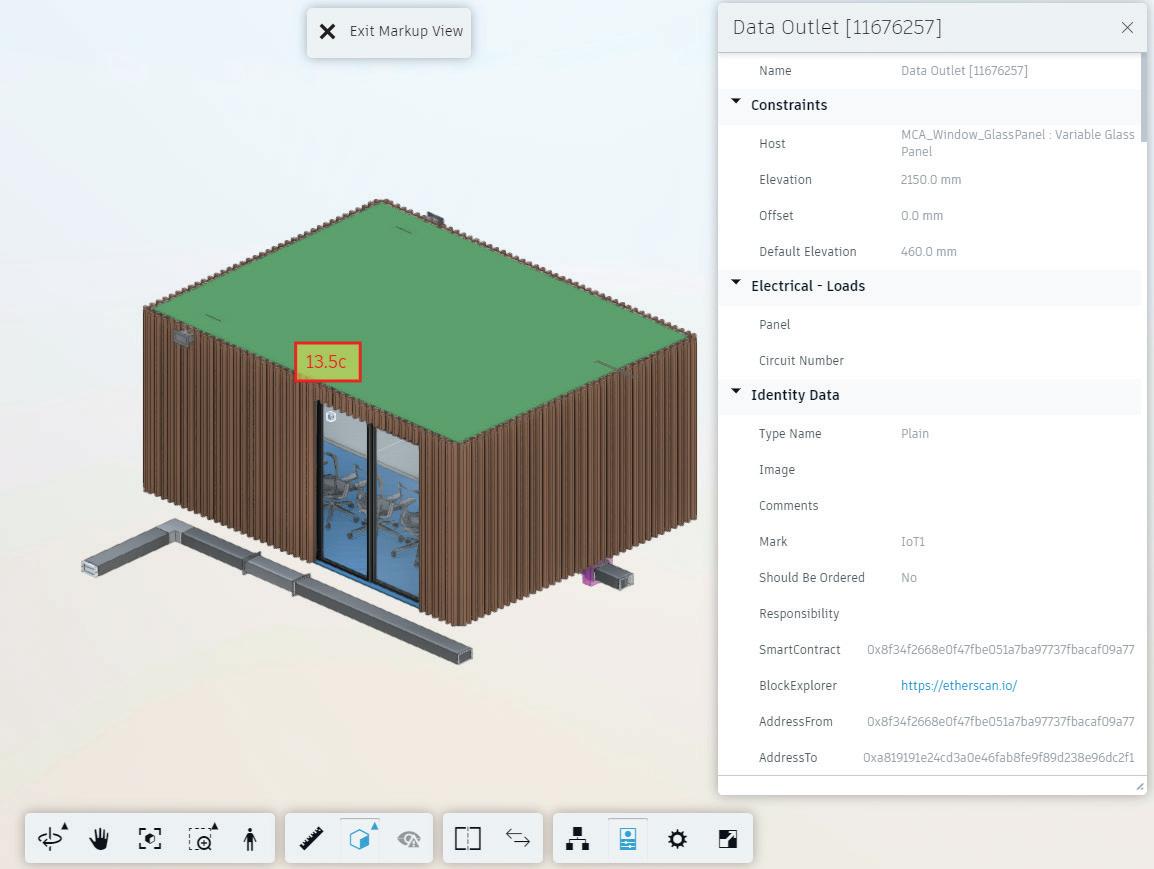
Figure 11 – BIM and IoT metadata in the web viewer Step 3 – Data from IoT sensor were linked into the digital model in the web app via a call function coded in JavaScript. This brings all the 3D visualization to the IoT application in the Azure IoT hub.
Step 4–With the web app setup, a smart contract then can be deployed. This contract enforced a specific function according to parameterspecifiedearlier. The humidity and temperature rules measurement were specified by initiating counterparty and deployed to the Blockchain Workbench. The smart contact application was built to secure the transactions data between multiple counterparties at any given time. This contract collected telemetry information from IoT devices installed in a location and enforced contract specifics related to conditions during occupation. Specifically, receiving and evaluating temperature and humidity data against an agreed upon acceptable range. If the IoT device identifies that the telemetry is out of the acceptable range, the contract will shift into an out of compliance state and appropriate O&M action need to be carried out. The smart contract functions translated in the Figure 11 and Figure 12.
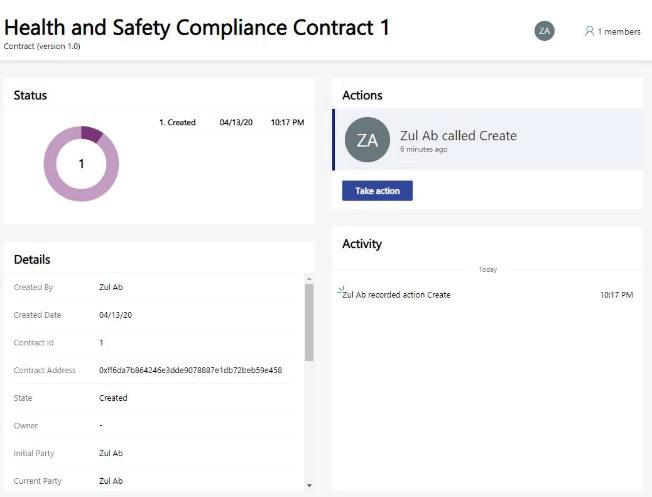
Figure 12 - Blockchain Workbench Smart Contract app Step 5 – The monitoring process was automated by the Logic app which performs “two actions – one related to user creation and the other to delivering the telemetry data. The Logic app is then pointed at the Service Bus which is populated by the IoT Hub” [40].
The Logic app (Figure 13) by default is configured to get triggered every minute to process any new message that is delivered by the IoT hub. Upon finding a new message, the Logic app creates messages as appropriate for user creation or executing the “Ingest Telemetry” function [40] until the life cycle is completed.

Figure 13 – Logic App functions Step 6 - The time-series events and activity were recorded inside the Blockchain distributed ledger validated by Ethereum Blockchain consortium. The DLT contained some data, the hash of the block and the hash of previous block. In this instance, each block stores the details information about temperature, humidity and occupancy. Once data recorded inside the Blockchain, details of the contract become immutable. This information can be viewed
at any point in time in the Blockchain explorer (Figure 14).
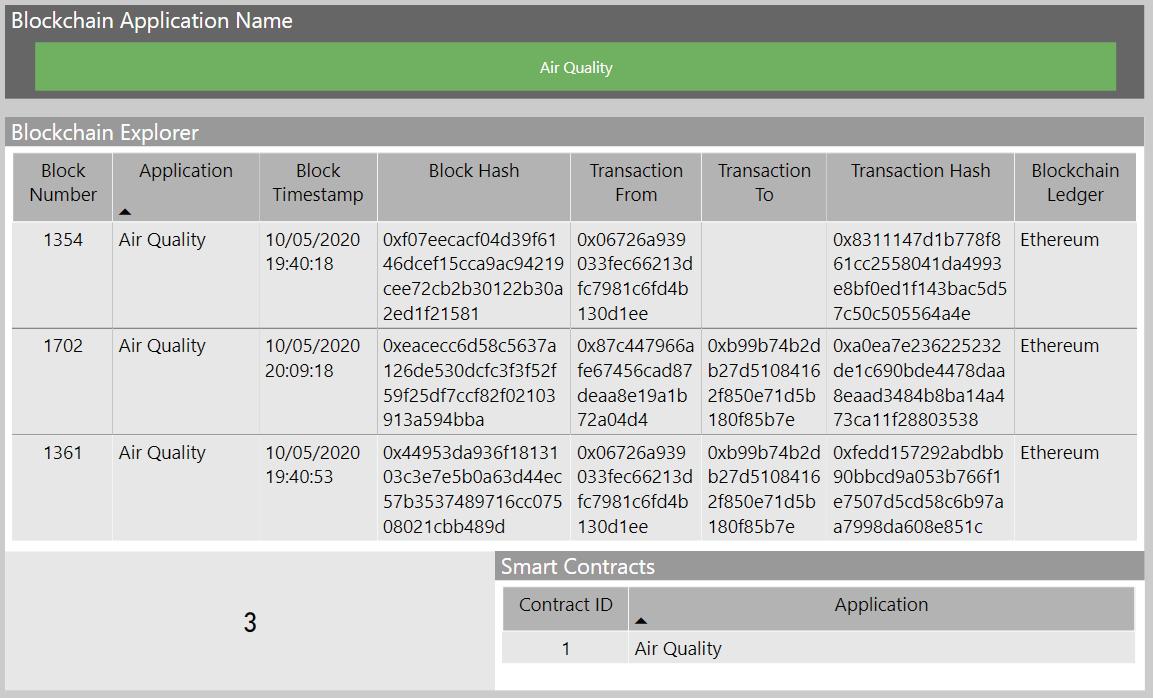
Figure 14 – Blockchain Explorer
4.0FINDINGS
The simulated application, though small in scale, was able to critically examinethe ability of the Blockchain technology and its characteristics to harmonize BIM and IoT data silos.
Upon examination, a connected and distributed Blockchain backed system provides integrity for transacted information between BIM and IoT environment. Verified data received within the environments were validated, recorded, and registered in the distributed ledger by a network of computers. This offers a foundation for a more transparent, secure, and better data exchanges model. This underlying mathematical Blockchain consensus will not only allow appropriate access to verified data but also improved quality control over individual data element between technologies and gave maximum flexibility over what data is shared and how. Such a holistic view of a single source of truth among participants can be achieved when trust is distributed, and consensus is applied to transactions with no central point of failure. Thus, the proposed Blockchain based systems and applications have the potentials to change organization culture, encourage information sharing, and improve collaboration between a BIM and IoT environment.
Findings demonstrated that the automation in data processing improves validation speed and efficiency of the data sharing in a BIM and IoT environment. Faster processing will also reduce the overall operating cost. This is an excellent economic case for businesses and supply chains. Furthermore, the virtual models can be used for developing operator training simulation systems, troubleshooting, production optimization and failure diagnoses. Thisis a powerful application during the O&M stage.
Further examination finds that the underlying Blockchain verified time-series datasets from BIM and IoT devices are useful for predictive data intelligence in the built environment and, to obtain an accurate future prediction, ie; a sequence of day-today air temperature datasets can be used to forecasts the life expectancy of materials. The integrity and validity of information presents in the Blockchain network constructs a world of analytics potential for technology such as deep learning, machine learning (ML) and artificial intelligence (AI) to train and create a robust neural network [41].
The output results from the Smart Contract indicated that immutable proof established by Blockchain consensus created trust in data management. By establishing relationship, trust can build upon BIM and IoT environments. Connected data could prevent anomalies and eliminate information loss and fragmented communication between architects, engineers, contractors, and facility managers.
Blockchain integration could correspondingly pointedly minimise the overall costs in resolving reconciliation while mitigating errors and the buildup of unreconciled items at each stage of a project, which needs data authentication by automating trust. This ability will allow organizations to act timely consistent. Such a thought-driven process will promote ethical business and data governance between the parties involved. Without intermediaries, the smart contract enables a faster and efficient data models validation process. This multi-directional integration of smart contract and Blockchain applications in the BIM and IoT process will ultimately provide a value that can facilitate organisations improving their productivity, quality, and transparency in collaboration. This feature will revolutionise how contracts and processes are managed in the AECO industry in the future.
Furthermore, the Blockchain technology supported the standardisation of data by setting up a harmonised digital platform for BIM and IoT data accessibility. The combination between these technologies could offer greater data provenance and complete traceability of known events between multiple parties in the collaborative silos.
Perhaps by emphasizing Blockchain’s potential role in promoting better collaboration and integration between BIM and IoT environment would reveal the real benefits of leveraging these technologies would finally be utilized. Harmonizing data silos encourages the AECO industry landscape to develop into a more collaborative, flexible, and creative environment, as the community promotes a transparent, interconnected, and distributed ecosystem that upholds trust. Originality and value of the building life cycle can be redefined.
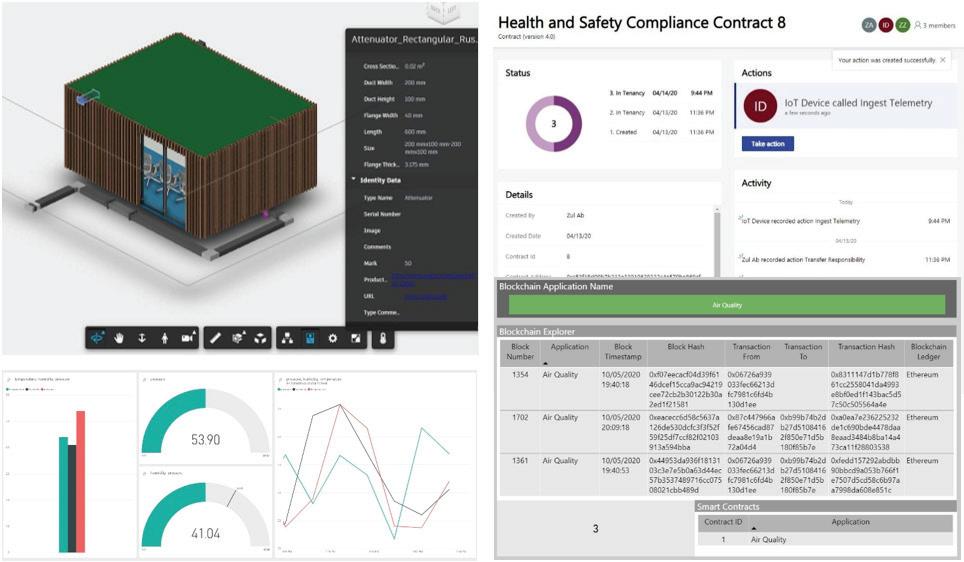
Figure 15 - Power BI dashboard.
5.0 DISCUSSION
Blockchain technology implementations in the BIM and IoT integration promise many benefits for the AECO industry. However, this integration has shown various adoption challenges.
One of the major challenges in this integration is scalability. Gartner Inc. forecasts, about 25.1 billion IoT devices were estimated to be installed by 2021 [42]. Such massive number of connected devices require a larger network for transaction verification. Increasing block size limit in the Blockchain network can cause verification delay and will turn into an expensive transactions bottleneck [43]. This scalability issues put limits to how data can be processed in a decentralized application. This limitation of the current Blockchain technology must be addressed before it can become a fully mainstream solution for the BIM and IoT integration.
Scalability issue in the Blockchain network could be solved with a new consensus algorithm, but it requires altering the Blockchain code which will expose the Blockchain network into another security challenge. Security is imminent for any decentralized businesses; any technology breach or security threat can lead to substantial losses. For example, the Decentralised Autonomous Organisation (DAO) Attack on 17 June 2016 by unknown hacker has resulted in the loss of 3.6 million Ether, or worth more than 1.3 billion dollars in today’s market. The only solution to fix the flaw code was to “hard-fork the Blockchain and revert it to the safe state. This remedy defeats the core values of Blockchain, such as immutability, decentralised trust, and selfgovernance” [44]. More emphasis must be placed on security policies, best practices, and intelligent security tools. The absence of a suitable Blockchain-based platform for managing, creating, and deploying BIM and IoT services for AECO industry creates an interoperability issue and possibly new fragmented silos if implement. Therefore, future research should focus on developing a reliable blockchain network with a set of Open protocols and Open standards that promotes a community development and support all applications instead of introducing the application on specific networks. This will eliminate data lock-in by specific vendor and reduce vendor dominance in IoT market.
Numerous Blockchain projects have attempted to create solutions for every industry. The race of becoming the first and leading project has defeated the purpose of having a reliable Blockchain network, because such act simply recreates collaboration silos and has caused a tremendous amount of energy waste in the past decade. The economic challenge of Blockchain technology adoption must be evaluated carefully if not, this could be another waste for the AECO industry. Therefore, formulating regulations for economical, reliable, and accessible Blockchain network for the AECO industry is vital for the technology to grow and benefit our built environment.
The organizational challenge must also be considered. The lack of awareness and assessment in the AECO organisations is the major issue. Therefore, a strategic approach for accessing education, training, research,and development solutions must be planned. Yet such measures were understood as the common obstacles for any new technology to mature, and there are limitations as a result. Therefore, the continuation of learning and support from the industry is critical for these technologies to succeed.
REFERENCES
[1] M. Paul, “Companies more worried about recession than new virus outbreak,” The
Irish Times, May 2020. [2] M. O. AlMuhairi, “Why COVID-19 makes a compelling case for the wider integration of blockchain,” World Economic Forum. Aug. 2020. [Online]. Available: https://www.weforum.org/agenda/2020/05/ why-covid-19-makes-a-compelling-casefor-wider-integration-of-blockchain/ [3] I. B. Kjartansdóttir, S. Mordue, P. Nowak, D. Philp, and S. J. Thór, “Building Information Modelling,” in Constrcution
Managers’ Library, 2017. [4] F. Filipowski, “Can Blockchain Eliminate the Data Silo?,” Dataversity. Jul. 2019. [Online]. Available: https://www.dataversity.net/canblockchain-eliminate-the-data-silo/ [5] P. Shi, H. Wang, S. Yang, C. Chen, and W. Yang, “Blockchain‐based trusted data sharing among trusted stakeholders in IoT,” Software: Practice and Experience, Sep. 2019, doi: 10.1002/spe.2739. [6] T. NBS, “The NBS,” The NBS. 2016. [Online]. Available: https://www.thenbs.com/knowledge/whatis-building-information-modelling-bim [7] P. Shillcock, “From BS 1192 to ISO 19650 and everything in between,” The NBS. Jan. 2019. [Online]. Available: https://www.thenbs.com/knowledge/frombs-1192-to-iso-19650-and-everything-inbetween [8] P. Barnaghi, W. Wang, C. Henson, and K. TAYLOR, “Semantics for the Internet of Things: Early Progress and Back to the Future,” International Journal on Semantic
Web & Information Systems, vol. 8, Sep. 2012, doi: 10.4018/jswis.2012010101. [9] A. Whitmore, A. Agarwal, and L. Xu, “The Internet of Things—A survey of topics and trends,” Information Systems Frontiers, vol. 17, Sep. 2014, doi: 10.1007/s10796014-9489-2. [10] N. Fotiou and G. C. Polyzos, “Smart Contracts for the Internet of Things: Opportunities and Challenges,” in 2018
European Conference on Networks and
Communications (EuCNC), 2018, pp. 256–260. [11] A. Shahrokni and J. Soderberg, “Beyond information silos challenges in integrating industrial model-based data,” CEUR
Workshop Proceedings, vol. 1406, pp. 63–72, Sep. 2015. [12] M. Fagan, K. N. Megas, K. Scarfone, and M. Smith, Foundational Cybersecurity
Activities for IoT Device Manufacturers. National Institute of Standards and Technology, 2020. [Online]. Available: https://doi.org/10.6028/NIST.IR.8259 [13] F. Mazhandu, “Implications of IoT Security in Construction Use Cases,” IoT for all. Aug. 2019. [Online]. Available: https://www.iotforall.com/implications-iotsecurity-construction-use-cases [14] A. Elmualim and J. Gilder, “BIM: innovation in design management, influence and challenges of implementation,” Architectural
Engineering and Design Management, vol. 10, no. 3–4, pp. 183–199, Jul. 2014, doi: 10.1080/17452007.2013.821399. [15] B. Charlès, “End-To-End Collaboration Enabled by BIM Level 3,” VélizyVillacoublay Cedex, France, 2014. Accessed: Sep. 29, 2020. [Online]. Available: https://ifwe.3ds.com/media/endto-end-collaboration-enabled-bim-level-3 [16] R. Eadie and M. McClean, An
Investigation of Interoperability Issues
Between Building Information Modelling (BIM) and E-Procurement. 2015. [17] Iotex, “A Decentralized Network for Internet of Things Powered by a PrivacyCentric Blockchain.” The Iotex Team, 2018. [Online]. Available: https://v1.iotex.io/white-paper [18] P. Stacey and D. Berry, “Extending Twolevel Information Modeling to the Internet of Things,” Jan. 2019. doi: https://doi.org/10.1109/WFIoT.2019.8767355. [19] J. Hunhevicz and D. Hall, Managing mistrust in construction using DLT: a review of use-case categories for technical design decisions. 2019. doi: 10.35490/EC3.2019.171. [20] B. Penzes, “Blockchain Technology in the Construction Industry.” Institution of Civil Engineers, London, Sep. 2018. doi: 10.13140/RG.2.2.14164.45443. [21] M. Mathews, D. Robles, and B. Bowe, “BIM+Blockchain: A Solution to the Trust Problem in Collaboration?,” Jul. 2017. doi: https://doi.org/10.21427/D73N5K. [22] A. Ciribini, M. Bolpagni, and E. Oliveri, “An Innovative Approach to e-public Tendering Based on Model Checking,”
Procedia Economics and Finance, vol. 21, pp. 32–39, May 2015, doi: 10.1016/S22125671(15)00147-1. [23] A. Narayanan, J. Bonneau, E. Felten, A. Miller, and S. Goldfeder, Bitcoin and
Cryptocurrency Technologies: A
Comprehensive Introduction. USA: Princeton University Press, 2016. [24] F. Hawlitschek, B. Notheisen, and T. Teubner, “The limits of trust-free systems: A literature review on blockchain technology and trust in the sharing economy,” Electronic Commerce Research and Applications, vol. 29, Mar. 2018, doi: 10.1016/j.elerap.2018.03.005. [25] F. Casino, T. K. Dasaklis, and C. Patsakis, “A systematic literature review of blockchain-based applications: Current status, classification and open issues,”
Telematics Informatics, vol. 36, pp. 55–81, 2019. [26] I. Kravchenko, “The List of Public Records Is Growing: Do You Want to Create Yours?” Mar. 2018. [Online]. Available: https://diceus.com/blockchainsoftware-development/ [27] H. Treiblmaier and T. Clohessy,
Blockchain and Distributed Ledger
Technology Use Cases Applications and
Lessons Learned: Applications and
Lessons Learned. 2020. doi: 10.1007/9783-030-44337-5. [28] M. Anderson, “Exploring Decentralization: Blockchain Technology and Complex Coordination. Journal of Design and Science,” 2019, [Online]. Available: https://jods.mitpress.mit.edu/pub/7vxemtm 3 [29] Y. Wang, The Abundance Prophecy: How
Blockchain, Cryptocurrencies and
Transformative Technology Will Guide
Humanity to Abundance. Amazon Media EU S.à r.l., 2018. [30] M. Walport, “Distributed Ledger Technology: beyond block chain,” London, 2015. [Online]. Available: https://www.gov.uk/go-science [31] N. Harish, K. Solvej, and G. Helen, “Distributed Ledger Technology and Blockchain,” Washington, DC, 2017. [Online]. Available: https://openknowledge.worldbank.org/han dle/10986/29053 [32] J. Li, M. Kassem, A. Ciribini, and M. Bolpagni, A Proposed Approach
Integrating DLT, BIM, IoT and Smart
Contracts: Demonstration Using a
Simulated Installation Task. 2019. doi: 10.1680/icsic.64669.275. [33] Y. Hanada, L. Hsiao, and P. Levis, “Smart Contracts for Machine-to-Machine Communication: Possibilities and Limitations,” in IEEE International
Conference on Internet of Things and Intelligence System, IOTAIS 2018, Bali,
Indonesia, November 1-3, 2018, 2018, pp. 130–136. doi: 10.1109/IOTAIS.2018.8600854. [34] A. Lipton and S. Levi, “An Introduction to Smart Contracts and Their Potential and Inherent Limitations,” Harvard Law
School Forum on Corporate Governance. May 2018. [Online]. Available: https://corpgov.law.harvard.edu/2018/05/2 6/an-introduction-to-smart-contracts-andtheir-potential-and-inherent-limitations/ [35] C. Kinnaird and M. Geipel, “Blockchain Technology: How the Inventions Behind Bitcoin are Enabling a Network of Trust for the Built Environment,” London, 2017. [36] P. Christensson, “P2P Definition,”
TechTerms. 2006. Accessed: May 05, 2020. [Online]. Available: https://techterms.com [37] S. Nakamoto, “Bitcoin: A Peer-to-Peer Electronic Cash System.” 2009. [Online]. Available: https://bitcoin.org/bitcoin.pdf [38] H. Nguyen, “Integration of BIM and IoT to improve the building performance for occupants perspective,” 2016. [39] E. Revision, “Solidity,” Solidity. 2020. [Online]. Available: https://solidity.readthedocs.io/en/v0.7.1/ [40] Microsoft, “What is Azure?,” Microsoft
Azure. 2020. [Online]. Available: https://azure.microsoft.com/enus/overview/what-is-azure/ [41] K. Sgantzos and I. Grigg, “Artificial Intelligence Implementations on the Blockchain. Use Cases and Future Applications,” Future Internet, vol. 11, p. 170, Aug. 2019, doi: 10.3390/fi11080170. [42] A. Gupta, T. Tsai, D. Rueb, M. Yamaji, and P. Middleton, “Forecast: Internet of Things — Endpoints and Associated Services, Worldwide, 2017,” London, Dec. 2017. [Online]. Available: https://www.gartner.com/en/documents/38 40665/forecast-internet-of-thingsendpoints-and-associated-ser [43] A. Reyna, C. Martín, J. Chen, E. Soler, and M. Díaz, “On blockchain and its integration with IoT. Challenges and opportunities,” Future Generation
Computer Systems, vol. 88, pp. 173–190, May 2018, doi: 10.1016/j.future.2018.05.046. [44] Y. Wang et al., “Formal Verification of Workflow Policies for Smart Contracts in Azure Blockchain,” 2020, pp. 87–106. doi: 10.1007/978-3-030-41600-3_7.

